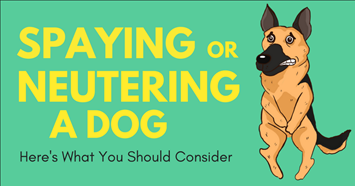Many pet owners opt to spay or neuter their pets, and spaying and neutering are important for reducing pet overpopulation.
What are the options?
If you decide to spay or neuter your pet, you have options. Discuss the options with Broadview Animal Hospital so you can make a decision that’s right for you, your family and your pet.
Surgical sterilization
During surgical sterilization, a veterinarian removes certain reproductive organs.
--Ovariohysterectomy, or the typical “spay”: the ovaries, fallopian tubes and uterus are removed from a female dog or cat. This makes her unable to reproduce and eliminates her heat cycle and breeding instinct-related behavior.
--Orchiectomy, or the typical “neuter”: the testes are removed from a male dog or cat. This makes him unable to reproduce and reduces or eliminates male breeding behaviors.
Surgical Alternatives to Traditional Spaying & Neutering
The procedures described above are the surgical procedures routinely used to spay or neuter dogs, but some pet owners opt for one of these alternatives:
Hysterectomy: the uterus and part of the fallopian tubes are removed from a female dog or cat. This makes her unable to reproduce, but her ovaries remain and will produce hormones. This may not eliminate the dog or cat’s behaviors associated with the breeding instinct.
Vasectomy: only the vas deference, which conducts sperm from the testes, are removed. This procedure makes the dog or cat unable to reproduce, but his testes remain and will produce hormones. This may not eliminate the dog or cat’s behaviors associated with the breeding instinct.
Ovariectomy: the ovaries are removed from a female dog or cat, but the uterus remains. Similar to ovariohysterectomy, this makes her unable to reproduce and eliminates her heat cycle and breeding instinct-related behavior.
Nonsurgical Sterilization
There is an approved product on the market used to neuter male cats and dogs that is injected into the testes to stop sperm production and render the dog or cat infertile. Because not all of the hormone-producing cells of the testes are affected by the drug, the testis will continue to produce some hormones. As research continues, additional products for nonsurgical sterilization may be developed.
Why Spay or Neuter?
Every year, millions of unwanted dogs and cats, including puppies and kittens, are euthanized. The good news is that responsible pet owners can make a difference. By having your dog or cat sterilized, you will do your part to prevent the birth of unwanted puppies and kittens. Spayingand neutering prevents unwanted litters, helps protect against some serious health problems,
and may reduce many of the behavioral problems associated with the mating instinct.
Removing a female dog or cat’s ovaries eliminates heat cycles and generally reduces the unwanted behaviors that may lead to owner frustration. Removing the testes from male dogs and cats reduces the breeding instinct, making them less inclined to roam and more content to stay at home.
Early spaying of female dogs and cats can help protect them from some serious health problems later in life such as uterine infections and breast cancer. Neutering your male pet can also lessen its risk of developing benign prostatic hyperplasia (enlarged prostate gland) and testicular cancer.
The procedure has no effect on a pet’s intelligence or ability to learn, play, work or hunt. Some pets tend to be better behaved following surgical removal of their ovaries or testes, making them more desirable companions.
What Are the Benefits of Spaying and Neutering?
There are several health and behavioral benefits that come with having your pet spayed or neutered:
Females
- Prevents unexpected pregnancies
- Prevents the heat cycle and spotting
- Reduces roaming tendencies
- Prevents mammary tumors
- Prevents uterine infections (such as pyometra)
Males
- Reduces or eliminates aggressive behavior
- Reduces roaming tendencies
- Eliminates or reduces marking and spraying
- Prevents testicular tumors
- Prevents prostate problems
Want More Information on Pet Spay & Neutering -- Links Below
https://www.petmd.com/dog/care/spay-and-neutering-dogs-101-everything-you-need-know
https://www.petmd.com/dog/care/evr_determining_best_age_to_spay_or_neuter
https://www.avma.org/public/PetCare/Pages/Low-cost-spay-neuter.aspx


Allow 24 hours for change of appointment. Discounts are given if no appointments are missed in two consecutive years.
